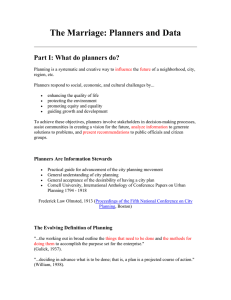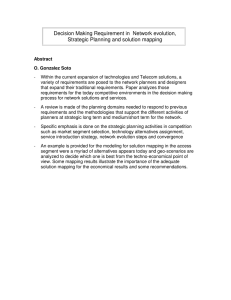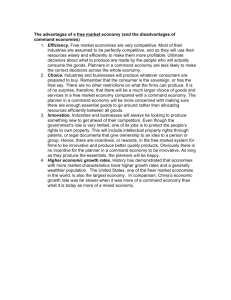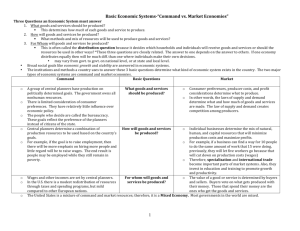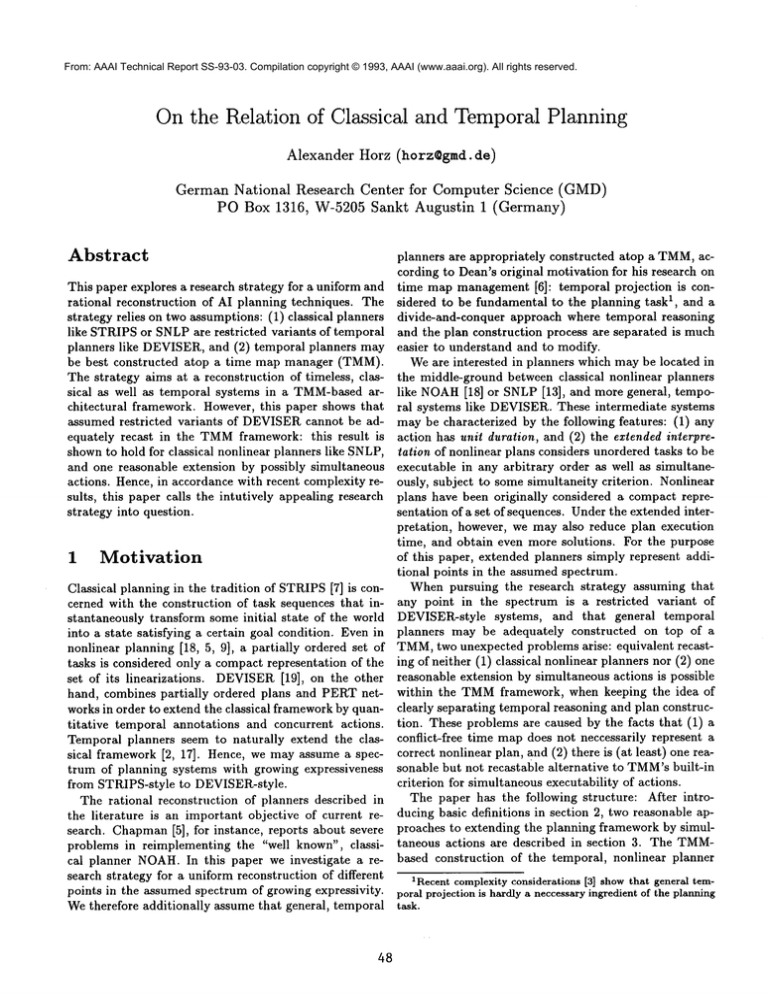
From: AAAI Technical Report SS-93-03. Compilation copyright © 1993, AAAI (www.aaai.org). All rights reserved.
Onthe Relation of Classical and TemporalPlanning
AlexanderHorz (horz©gmd.de)
GermanNational Research Center for ComputerScience (GMD)
POBox 1316, W-5205Sankt Augustin 1 (Germany)
Abstract
This paper explores a research strategy for a uniform and
rational reconstruction of AI planning techniques. The
strategy relies on two assumptions: (1) classical planners
like STRIPSor SNLPare restricted variants of temporal
planners like DEVISER,and (2) temporal planners may
be best constructed atop a time map manager (TMM).
The strategy aims at a reconstruction of timeless, classical as well as temporal systems in a TMM-basedarchitectural framework. However, this paper shows that
assumed restricted variants of DEVISERcannot be adequately recast in the TMMframework: this result is
shownto hold for classical nonlinear planners like SNLP,
and one reasonable extension by possibly simultaneous
actions. Hence, in accordance with recent complexity results, this paper calls the intutively appealing research
strategy into question.
1
Motivation
planners are appropriately constructed atop a TMM,according to Dean’s original motivation for his research on
time map management [6]: temporal projection is considered to be fundamental to the planning task 1, and a
divide-and-conquer approach where temporal reasoning
and the plan construction process are separated is much
easier to understand and to modify.
Weare interested in planners which may be located in
the middle-ground between classical nonlinear planners
like NOAH
[18] or SNLP[13], and more general, temporal systems like DEVISER.These intermediate systems
may be characterized by the following features: (1) any
action has unit duration, and (2) the extended interpretation of nonlinear plans considers unordered tasks to be
executable in any arbitrary order as well as simultaneously, subject to some simultaneity criterion. Nonlinear
plans have been originally considered a compact representation of a set of sequences. Under the extended interpretation, however, we may also reduce plan execution
time, and obtain even more solutions. For the purpose
of this paper, extended planners simply represent additional points in the assumed spectrum.
When pursuing the research strategy assuming that
any point in the spectrum is a restricted variant of
DEViSER-style systems, and that general temporal
planners may be adequately constructed on top of a
TMM,two unexpected problems arise: equivalent recasting of neither (1) classical nonlinear planners nor (2)
reasonable extension by simultaneous actions is possible
within the TMMframework, when keeping the idea of
clearly separating temporal reasoning and plan construction. These problems are caused by the facts that (1)
conflict-free time map does not neccessarily represent a
correct nonlinear plan, and (2) there is (at least) one
sonable but not recastable alternative to TMM’sbuilt-in
criterion for simultaneous exeeutability of actions.
The paper has the following structure: After introducing basic definitions in section 2, two reasonable approaches to extending the planning framework by simultaneous actions are described in section 3. The TMMbased construction of the temporal, nonlinear planner
Classical planning in the tradition of STRIPS[7] is concerned with the construction of task sequences that instantaneously transform some initial state of the world
into a state satisfying a certain goal condition. Even in
nonlinear planning [18, 5, 9], a partially ordered set of
tasks is considered only a compact representation of the
set of its linearizations.
DEVISER
[19], on the other
hand, combines partially ordered plans and PERTnetworks in order to extend the classical frameworkby quantitative temporal annotations and concurrent actions.
Temporal planners seem to naturally extend the classical framework [2, 17]. Hence, we may assume a spectrum of planning systems with growing expressiveness
from STRIPS-style to DEVISER-style.
The rational reconstruction of planners described in
the literature is an important objective of current research. Chapman[5], for instance, reports about severe
problems in reimplementing the "well known", classical planner NOAH.In this paper we investigate a research strategy for a uniform reconstruction of different
1 Recentcomplexityconsiderations[3] showthat general tempoints in the assumed spectrum of growing expressivity.
poral projection is hardly a neccessaryingredient of the planning
Wetherefore additionally assume that general, temporal task.
48
TRIPTIC[17] is sketched in section 4. Section 5 shows
that the TMM-framework
may adequately recast one extension described in section 3 but neither classical planners nor the alternative extension. Section 6 concludes.
2
<tl>
+
p
o¢
~+~~~ii
~
<qoal>
Basic Definitions
<t2>
Let A be the set of atomic actions, each of which is a
partial function from W to W, where W is the set of
possible world states. For any state w 6 W and any
formula ¢ let w ~ ¢ denote that w is a model of ¢, i.e.
¢ is true in w. World states are represented by subsets
of £, the set of essential [11] sentences. A set S C ~ is
maximally legal iff the set Ws = {w 6 WIV¢6 S : w
¢} of world states represented by S is a singleton.
Classical planning in the tradition of STRIPS[7] describes actions by triples (Po, Do, Ao), the precondition,
delete set and add set of the operator o which is interpreted as the (atomic) action fo. Since it is sufficient
to show our main result for a specific type of classical
planning tasks, we further consider a specific type of operators, only: we restrict 1’o to a set (conjunction)
essentials, enforcing that S tO K t- Po ¢~ S D_ Po, where
K is the (unused) background knowledge about (maximally) legal sets of essentials. Operator o is legal iff
result(o, S) is maximally legal, for any maximally legal
S 3_ Po, and Do N Ao = O.
Soundnesof operators [11] is not sufficient for our purpose: if (Po,Do,Ao) is sound with respect to fo, then
so are, e.g., (Po, Do, 0) or (Po, £, Ao). Sound operators
mayhappen to predict the state of affairs resulting from
action execution very weakly while legal operators are
maximallypredictive with respect to essential sentences.
Conflict managementof classical nonlinear plans is a
central issue for this paper. Due to the lack of space, the
reader is referred to the formal model in [9]; the simple
examplein figure i mayserve as an illustration. The plan
contains four dependencies: One between -*tart and tl,
and one between start and t2, both concerning condition p. The third dependency is between t l and goal
concerning q, the fourth between t2 and goal concerning r. Furthermore, the plan contains two conflicts: task
el denies the precondition p of task t2, maybe executed
before t2, and violates the dependency between -*tart
and t2 concerning p (and vice versa). Hence, the plan
no solution under the classical interpretation (see [9] for
further details).
3
%%
_
¯
<start>
+q
Simultaneous
Actions
Classical
Framework
in the
Classical planning considers actions as sequentially and
instantaneously transforming the world. Even when ignoring durations of actions, planners which take possible
49
+r,-,
Figure 1: A simple, nonlinear plan; dashed curves show
dependencies
simultaneity into account may produce novel solutions,
and help reduce plan execution time.
A first design of such planners would require cumbersome domain models including explicit descriptions
of any possible complex action formed by simultaneous
execution of two or more atomic actions. As the major limitation, the domainmodelling effort would, in the
worst case, grow unacceptably from linear to exponential in the original number of atomic actions. Pelavin’s
[15, pp. 17611] approach, which requires explicit modelling of noninterference conditions between atomic actions, as well as Grot3e and Waldinger’s [8] "possible"
predicate also suffer from combinatorial explosion.
In essence, we are looking for a rule predicting the
applicablity and effects of complexactions, given only the
descriptions of the respective atomic constituents. The
rule for description composition is required to preserve
soundnes and legality, i.e. we require the rule’s result to
be a sound and legal description of the complex action.
The complex action resulting from simultaneous execution of a and b, again a partial function from W
to W, is denoted allb; sequential execution is denoted
aob. Viewing atomic actions as functions gives us no hint
about the result of simultaneous execution. However, we
may reasonably identify simultaneous executability with
(1) independence or (2) coherence of actions. These
teria are not equivalent, as described below.
3.1
Independence
One reasonable criterion for simultaneous executability
may be easily understood by applying the extended interpretation to classical nonlinear solutions:
Definition
1 (Independence
Assumption)
dependence assumption holds if and only if
The in-
¯ any two actions a and b are simultaneously executable in world state w if and only if sequences
a o b and b o a are executable in w, and
¯ simultaneous execution yields a result identical
execution in any arbitrary order.
to
3.3
Figure 2: A situation in the two-handed blocks world.
Obviuosly, descripiton composition according to the
independence assumption preserves soundnes and legality, as required. For an example of independent actions, consider a slightly extended version of the blocks
world where two robot hands are available.
The actions respectively correspondingto move(It 1, A, B, ¢) and
move(1t2,D, E, F) are independent according to our definition, and they are simultaneously executable in the
situation depicted by figure 2. However,the actions corresponding to raove (H1 ,A,B ,F) and move(H2,D ,E,F)
neither independent nor simultaneously executable.
3.2
Coherence
Although the independence assumption is reasonable,
there are temporal planners (e.g. DEVISER
[19]) which
implicitely employa different criterion.
For any action descriptions el = (Pol, Dol,Aol) and
02 = (Po2,Do2,Ao2) let 01102 denote (Pol U Po2,Dol t_J
Do2,Aol U Ao2). Actions fol and fo2 are coherent in
world state w if and only if V¢ E Pol U Po~ : w ~ ¢, and
el 1o2is legal.
Definition
2 (Coherence Assumption)
ence assumption holds if and only if
The coher-
¯ Any two actions fox and re2 are simultaneously executable in world state w if and only if re1 and re2
are coherent in w, and
¯ 01102 is a sound and legal description of foXllfo2,
for any sound and legal descriptions el and o2 of
re1 and re2, respectively.
Recall the example: as required, move(H1,A,B,C)and
move(lt2,D,E,F) are coherent, while movo(H1,A,B,F)
and movo(H2,D,E,F) aren’t. Obviously, coherence
necessary but insufficient for independence. Tasks t i
and t2 (cf. figure 1) form a simple example.
Note that neither independence nor coherence are generally equivalent to simultaneous executability. However,
they are assumedto be in [16, 14] and [19, 6, 4], respectively. Thus, the respective assumption built into a specific planner must be explicitely stated, since the domain
modeller has to take it into account. A more detailed discussion about independence respectively coherence may
be found in [10].
5O
Classical
Planning
with
Simultaneity
Assuming independence, a nonlinear plan of sound operators solves a problem under the classical interpretation
if and only if it solves the problem under the extended
interpretation
where unordered, independent tasks may
be simultaneously executed. Hence, when assuming independence, we may simply employ an unmodified, classical nonlinear planner.
However, when executing the plan, we still have to
check independence: In a correct nonlinear plan, two
tasks may remain unordered if there is no conflict between either of the tasks and a dependency concerning a
precondition literal or a producedeffect of the other task.
Hence, neither of two respectively unordered tasks may
deny the other task’s preconditions or the other task’s
effects that are used later in the plan. Since someeffects
mayremain unused, unorderedness is not a sufficient condition for independence.
Let us now consider the impacts of the coherence assumption on the design of an extended nonlinear planner.
Provided the coherence assumption, we may only state
that any classicM nonlinear solution is also a solution under the extended interpretation. The plan in figure 1 is
a counterexample for the reverse direction: Under the
classical interpretation, it is impossible to resolve the
double-cross conflict formed by two right-forks without
introduction of a new task. When assuming coherence
of tl and t2, however, we may resolve both conflicts by
merging tl and t2 into t111;2.
In general, a new conflict resolution rule maybe introduced: Not only may we prevent the conflictor D from
being executed between the producer P and the user U,
or introduce a different c-producing task P’ between D
and U (cf. [9]). Provided coherence of the actions corresponding to U and D, we may also resolve the conflict by
merging the user U and the conflictor D into a legal task
UID.
Consequently, planners assuming coherence may be
considered a little more general than those assuming independence: they may produce more solutions.
4
TRIPTIC: A Temporal,
linear Planner
Non-
This section explores the second assumption underlying
the research stratgey under consideration. It describes
TRIPTIC, a temporal nonlinear planner [17] which is
implemented in CommonLisp on top of a corrected and
extended reconstruction [12] of Dean’s TMM.The lack
of space requires concentration on aspects relevant for
the purpose of this paper.
Assuming that. an adequate design of temporal planners reflects the division of labor mentionedin section 1,
TRIPTICis designed according to the following princi-
interval boundaries nor introduction of *pos-tiny* and
*neg-l:iny* seem to be generally sufficient. However, we
won’t go into further details, here.
5
Figure 3: Solving a right-fork; bold and dashed lines
show task resp. condition tokens.
Dubious Intution
In section 1, we sketched a research strategy for a unifying view of planning systems. It assumes the spectrum of growing expressivenes, which has been explored
in section 3, as well as the appropriateness of the TMMframework, which has been confirmed in section 4. Surprisingly, the intuitively appealing assumptions must be
called into question due to the following reason: TMMbased temporal planners do not generalize classical nonlinear planners and extended classical planners assuming
independence.
The impossibility of recasting classical nonlinear planners may be explained at the plan presented in figure 1:
this plan is not conflict-free,
hence no solution. The
TMM,however, would constrain intervals tl and t2 to
be equal, since the "double-cross" conflict is a combination of two "right-fork" conflicts. TRIPTIC’sbuilt-in
criterion for simultaneous executability of tasks is coherence: the resulting time map would not contain any
pair of intersecting, contradictory tokens, hence would
be considered a representation of a solution plan.
The only resort would be a means for enforcing mutual
exclusion of different task intervals. However,this would
not only contradict the essential idea of least commitment in nonlinear planning; it is not possible by partially
ordering interval endpoints [1, p. 16]. Here, we could replace the TMM
by a interval-based reasoner as it is done
in ILP [1, p. 16]. However, this would be no solution
for the problem of recasting extended planners assuming
independence, where simultaneity should be possible.
Extended planners assuming independence cannot be
recast in the TMM-framework,since independence is
equivalent to the conditions that (1) preconditions are
required to persist until the end of the task, (2) postconditions are already produced when the task starts, and
(3) contradictory tokens "belonging" to the same task
have to be ignored. Obviously, condition (3) contradicts
the division of labor between the planner and the TMM.
Hence, at least one of the underlying assumptions must
be invalid: temporal planners do not generalize (extended) classical planners, i.e. there is no spectrum of
growing expressivenes, or temporal nonlinear planners
may not be adequately designed in the TMMframework.
pies: The TMM
handles all temporal relations, in particular it is responsible for the detection of conflicts and possible helpful interactions. The planner has to explicitely
establish dependencies between tasks, especially their organization towards the goal.
Conflict managementin TRIPTICis of further interest, here. Technically, the TMM
detects conflicts by detecting possibly intersecting, contradictory token pairs.
Conflicts may be resolved by introduction of clipping
constraints. Whenthere is only one allowable clipping,
this is automatically done by the TMM.Otherwise, the
planner has to eventually select one alternative clipping.
Tasks are represented by task tokens. Figure 3 shows
the TMM-representation of the (solved) right-fork conflict [9]. Bold lines show task tokens, dashed lines show
condition tokens, and (clipping) constraints are represented by (bold) arrows. The precondition of tasks are
represented by condition tokens which are constrained to
be true at the start of the respective task; the effects are
constrained to be true at the task’s end and to start after
the task starts. Note that here and in the sequel, "after"
mayalternatively be read "after or exactly when", since
(clipping) constraints maybe closed intervals of length
0; the same holds for "before." Dependencies are established by "stretching persistences" [6]. This implies a
truth criterion ignoring "white knights" [5].
Consider the example in figure 3, where the dependency between P and N concerning ¢ is conflicted by D.
This "right-fork" would be detected and resolved by the
TMM,because token +¢ may intersect token -¢. Since
+¢ definitely starts before -c, the unique allowable clipping CCconstraining +¢ to end before -e starts will be
automaically introduced. Note that, as a "side-effect",
CCconstrains !I to start before D ends. Wemay alternatively mimic DEVISER’sbehavior by additionally constraining a task’s precondition to persist at least until the
task ends, and constraining the effects to start exactly
when the task ends. In this case, CC would additionally
constrain tl to end before D ends.
Summarizig in short, the TMM-basedframework sup- 6
Conclusions
ports a conceptually clear design of temporal planners.
An adequate task representation causing no problems in Wehave explored a research strategy for a unifying view
the calculation of interval intersections is still subject to of planning systems. The strategy assumes a spectrum of
future research: neither a mixture of open and closed growing expressivenes from STRIPS-style to DEVISER-
51
style systems, and that temporal planners may be adeditor, Proc. 1st European Workshop on Planning
equately designed in a TMM-framework. However, we
(EWSP-91), pages 78-87, 1991.
obtained the contradiction that less expressive systems
[9] Joachim Hertzberg and Alexander Horz. Towards
cannot be recast by a TMM-basedtemporal planner, i.e.
a Theory of Conflict Detection and Resolution in
TMM-basedtemporal planners do not generalize (exNonlinear Plans. In Proceedings of the 11th IJCAI,
tended) nonlinear planners. In accordance with recent
pages
937-942, 1989.
complexity results [3], this contradiction calls the intuitively appealing research strategy into question.
[10] Alexander Horz. Relating Classical and TempoFuture work, thus, has to investigate the following isral Planning (Preliminary Report). In Proc. 7th
sues: The idea of a spectrum is still appealing, although
German Workshop on Planning and Configuration,
it may not have the assumed shape. Although seeming
1993.
questionable, the TMM-basedconstruction has advantages over previous approaches. What should be kept [11] Vladimir Lifsehitz. On the Semantics of STRIPS.
In Michael P. Georgeff and AmyL. Lansky, editors,
from this idea?
Reasoning about Actions and Plans, pages 1-9. Morgan Kaufmann, 1987.
7
Acknowledgements
[12] Stefan Materne and Joachim Hertzherg. MTMM
Correcting and Extending Time Map Management.
In Joachim Hertzherg, editor, Proc. 1st European
Workshop on Planning (EWSP-91), pages 88-99,
1991.
This work has been partially Supported by the German
Ministry for Research and Technology (BMFT) under
grant ITW 8900 A7. Thanks to Tom Gordon, Gerd
Grol]e, Joachim Hertzberg and Eric Rutten for valuable
commentson earlier drafts.
References
[13] David McAllester and David Rosenblitt. Systematic
Nonlinear Planning. In Proc. AAAI-91, pages 634639, 1991.
[1] James Allen. Temporal Reasoning and Planning.
In James Allen, Henry Kautz, Richard Pelavin, and
Josh Teneneberg, editors, Reasoning About Plans,
chapter 1. Morgan Kaufmann, San Mateo (CA),
1991.
[14] Edwin P. D. Pednault. Formulating Multi Agent
Dynamic World Problems in the Classical Planning
Framework. In Michael P. Georgeff and AmyL.
Lansky, editors, Reasoning about Actions and Plans.
Morgan Kaufmann, 1987.
[2] James Allen and Johannes Koomen. Planning Using
a Temporal World Model. In Proc. IJCAI-83, pages
741-747, 1983.
[15] Richard Pelavin. Temporal Reasoning and Planning. In James Allen, Henry Kautz, Richard
Pelavin, and Josh Teneneberg, editors, Reasoning
About Plans, chapter 3. Morgan Kaufmann, San Mateo (CA), 1991.
[3] Christer B~ckstrom and Bernhard Nebel. On the
Computational Complexity of Planning and Story
Understanding. In Proc. ECAI-92, 1992.
[16] Pierre Regnier and Bernard Fade. Complete Determination of Parallel Actions and Temporal Optimization in Linear Plans of Actions. In Joachim
Hertzberg, editor, Proc. 1st European Workshop on
Planning, pages 100-111, 1991.
[4] Priklis Belegrinos and Michael Georgeff. A Modelof
Events and Processes. In Proc. IJCAL pages 506511, 1991.
Temporal
[17] Eric Rutten and Joachim Hertzberg.
Planner = Nonlinear Planner + Time Map Manager. TASSOReport 40, Gesellschaft fiir Mathematik und Datenverarbeitung
mbH (GMD), Sankt
Augustin, 1992. (revised version will appear in AI
Communications, vol. 6, 1993).
[5] David Chapman. Planning for Conjunctive Goals.
Artificial Intelligence, 32:333-377, 1987.
[6] Thomas Dean and Drew McDermott. Temporal
Database Management.Artificial Intelligence, 32:155, 1987.
[7] Richard E. Fikes and Nils J. Nilsson. STRIPS:
A New Approach to the Application of Theorem
Proving to Problem Solving. Artificial Intelligence,
2:189-208, 1971.
[18] Earl D. Sacerdoti. The Non-linear Nature of Plans.
In Proc. of the ~th IJCAI, pages 206-214, 1975.
[19] Steven A. Vere. Planning in Time: Windows and
Durations for Activities and Goals. IEEE Trans.
PAMI, 5:246, 1983.
[8] Gerd Grot3e and Richard Waldinger. Towards a Theory of Simultaneous Actions. In Joachim Hertzberg,
52



